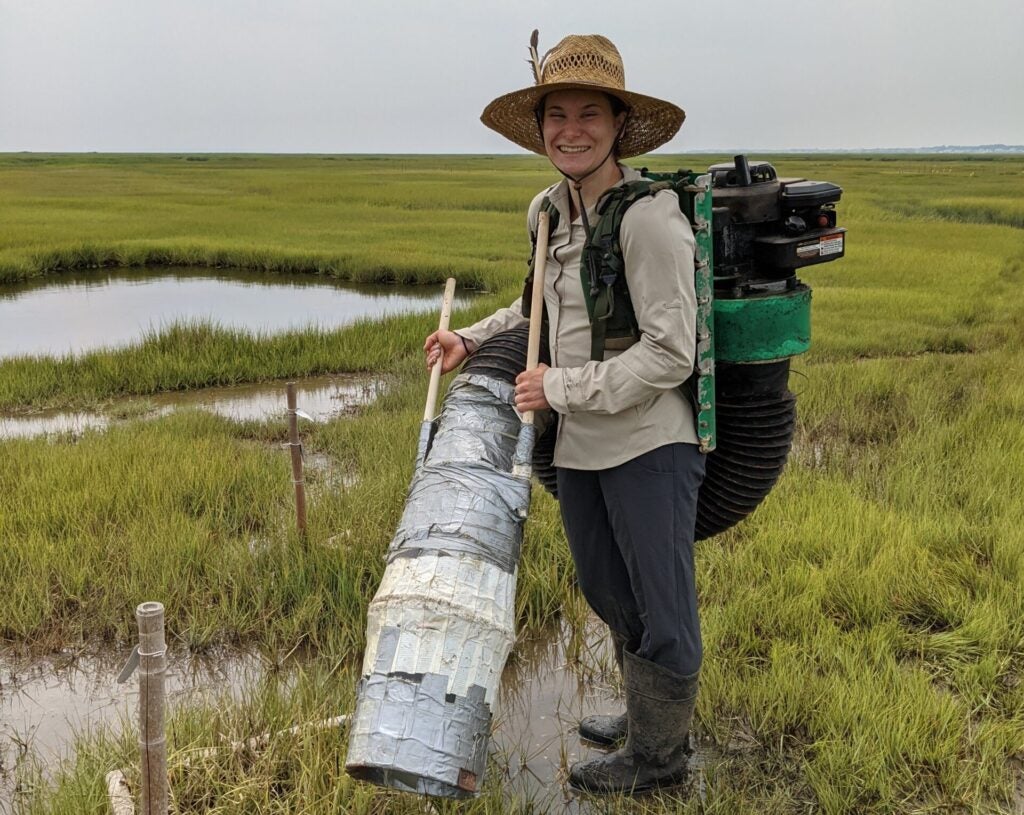More than Meets the Eye
Why salt marshes are key to climate mitigation
Author: Alannah Nathan, SFS’ 24
Often overlooked, salt marshes serve an essential role in protecting the environment and mitigating climate change.
In 2016, Matthew Hamilton, the Founding Director of the Environmental Biology undergraduate major at Georgetown, and Gina Wimp, the Director of Graduate Studies in the Biology Department, set out to study salt marshes and, more specifically, their genetic variability.
Not only do salt marshes act as an important buffer between land and sea – safeguarding against storm surge, sea level rise, and erosion – salt marshes are among the most efficient carbon sinks. In fact, coastal wetlands, which include salt marshes, hold 30% of soil carbon, despite accounting for just 5% of the Earth’s landmasses. These marshes fulfill other important roles too: they protect against nutrient overload, filter out pollutants such as heavy metals, and serve as a nursery ground for fish and shellfish.
Despite their vital role to the protection of the planet, the world is currently losing salt marshes at an alarming rate as a result of nutrient runoff and industrial and residential development. Today, roughly half of the world’s salt marshes are at risk.
As biologists work to restore these salt marshes, an understanding of their genetic makeup is essential. Genetic makeup ultimately determines their ability to sequester carbon, filter out pollutants, or protect against nutrient overload.
Genetic variability in salt marshes is key. As Wimp notes, “The more genetic diversity you have [in an ecosystem], the more tools you have in your toolbox” to adapt against sea-level rise, protect against erosion, filter toxic pollutants, etc. Therefore, a measurement of salt marsh genetic diversity proves key to understanding their role in ecosystems.
Over the past five years, Dr. Hamilton has laid a groundwork for a methodology to explore genetic variability in salt marsh ecosystems. To do so, he’s developed two key tools.

First, he has designed genetic markers for salt marsh grasses and several insect species that live within the ecosystem. Genetic markers are labels that distinguish genetically distinct individuals. These genetic markers allow him to measure patterns of genetic variation—that is, how salt marsh DNA differs amongst individuals.
Second, Professor Hamilton has developed a novel computational approach to estimate the rate of clonal reproduction in marsh grasses. His model is based on information of how genetic makeup and difference varies across space in an ecosystem. With this tool, they can answer determine how, for example, genetic variation of salt marsh organisms differs from the outer edge of the ecosystem versus its interior.
Such genetic markers and computational approaches are used to understand how genetic variation amongst plants explains how they respond to their environment – including human-induced changes such as nitrogen pollution.
Their research has also focused on eco-evolutionary dynamics within salt marshes. Eco-evolutionary dynamics refer to the study of how genetic processes interact with and influence ecological variation. In particular, Dr. Hamilton and Dr. Wimp have studied how insect populations affect salt marsh populations. Using genetic markers, they can test if and to what extent genetic variation in salt marshes influences insect populations.
They can also test how changing ecological conditions – including predator density, nutrient availability, and human-influenced factors – impact insect and plant populations. An understanding of salt eco-evolutionary dynamics within salt marshes is important in the restoration of these habitats.
The more genetic diversity you have [in an ecosystem], the more tools you have in your toolbox.
Director Gina Wimp
The researchers’ work has important implications for conservation efforts in a changing environment. Too often, habitat restoration takes the form of uniformly planting genetically identical plants. Genetic uniformity limits organisms’ ability to play diverse roles in their respective ecosystem – including their ability to adapt to changing environments. Unsurprisingly, such genetic variability is essential in a rapidly changing environment.
Dr. Wimp and Dr. Hamilton’s work is critical in two of the 21st century’s greatest challenges: the preservation of biodiversity and the mitigation of climate change.
Interested in learning more about Dr. Wimp and Dr. Hamilton’s research?
Further reading:
- Wimp GM, Tomasula J, and Hamilton, MB. 2019. Putting the genes into community genetics. Molecular Ecology 28(19):4351-4353. doi.org/10.1111/mec.15209
- Gina Wimp’s Lab Website
- Matthew Hamilton’s Lab Website

